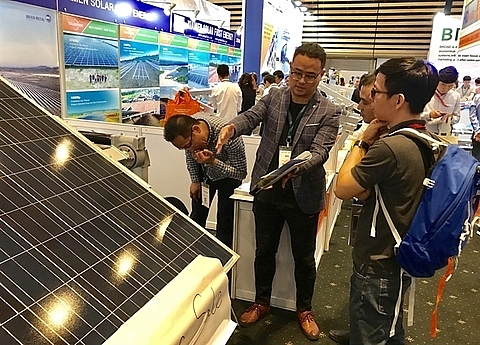Commercial banks provide loans for green energy projects
 |
| Visitors look at a booth at the Solar Show 2019 held recently in HCM City. VNS Photo Bo Xuan Hiep |
As solar energy becomes more popular, lenders in Viet Nam are looking to fund consumers who want to install solar panels on their own homes.
They are offering loans at interest rates as low as 10-13 per cent a year. Lenders are also cooperating with local manufacturers to offer discounts to borrowers.
One of the banks to offer such loans is HSBC Viet Nam. Partnering with GIC Investment Joint Stock Company (GIC), HSBC is offering new loans for rooftop solar panels to help customers reduce the cost of electricity bills by leveraging an unlimited energy source.
More solar power sources in the country are expected to ease pressure on the national power supply and contribute to a more sustainable future for the country.
HSBC loan applicants can receive financing at unsecured loans at variable interest rates as low as 11.99 per cent with a long repayment term of up to 60 months.
Applicants must be current HSBC Viet Nam customers who want to install a rooftop solar energy system for their home in either Da Nang or HCM City.
Customers who take out the loans can also enjoy preferential discounts on GIC products.
Le An Khang, chairman of GIC, said that an increasing number of Vietnamese were willing to invest in solar energy because of its sustainability and lower costs.
Meanwhile, the Bank for Investment and Development of Viet Nam (BIDV) has partnered with SolarBK to fund up to 75 per cent of costs related to household solar energy projects.
The bank’s insurance arm, BIC, offers five-year warranties, a move intended to boost the credibility of SolarBK’s products.
The repayment terms range between 12 and 36 months, with interest rates at 10 per cent per year, with interest waived for the first year.
Speaking at the launch ceremony, Le Manh Hung, CEO of BIDV Vung Tau-Con Dao, said that financial institutions were still hesitant to enter this new sector which requires time and effort to understand.
Other banks in the market, including HDBank and Oriental Commercial Bank, have also encouraged Vietnamese enterprises to use solar energy in their operations.
Foreign investment
Recently, a joint venture between the Bamboo Capital Group and Viet Nam-Oman Investment Fund opened the BCG-CME Long An 1 solar power plant in Long An Province.
Located in Thanh Hoa District, the plant has a capacity of 40.6 MWp and costs VND1.088 trillion (US$46.57 million).
Pham Van Canh, deputy chairman of Long An Province Peoples Committee, said the province has 16 solar power projects with a total capacity of 1,472MW.
According to the Ministry of Industry and Trade, the country’s total capacity of solar power projects (already approved and currently under consideration for approval) is about 26,000 MWp.
These projects had attracted large amounts of credit capital from domestic banks, foreign partners and large international financial institutions, the ministry said.
Ousmane Dione, World Bank Country Director for Viet Nam, said that private investors had shown interest in Viet Nam’s growing energy sector, especially renewable energy.
He said the Government should ensure a transparent and stable regulatory environment with a proper risk-sharing mechanism among all parties.
Experts have said that solar panels in residential areas would ease the strain on the national power grid and have a positive environmental impact.
Power demand in the country is projected to increase by 8 per cent annually in the 2021-2031 period.
The country needs 60,000MW of electricity by 2020, 96,500MW by 2025, and 129,500MW by 2030, according to surveys.
While demand is rising, traditional supply sources like coal and thermal energy are struggling to keep up.
Renewable energy sources such as solar power are steadily gaining attention as the best solution for both households and major corporations.
Viet Nam has targeted raising total renewable energy production from 58 billion kWh in 2015 to 101 billion kWh in 2020, 186 billion kWh in 2030, and 452 billion kWh in 2050.
Under Viet Nam’s renewable energy development strategy, approved in 2015, the country aims to increase the ratio of electricity from renewable sources from 35 per cent of total output in 2015 to 38 per cent by 2020, and to 43 per cent by 2050.
What the stars mean:
★ Poor ★ ★ Promising ★★★ Good ★★★★ Very good ★★★★★ Exceptional
Related Contents
Latest News
More News
- Heavy industries set for pilot greenhouse gas quotas (December 25, 2025 | 10:00)
- Swedfund invests in MSME growth and climate action in Vietnam (December 19, 2025 | 11:42)
- GreenYellow brings solar energy to light up remote schools in Tuyen Quang province (December 19, 2025 | 08:00)
- Charge+, Grab partner to develop EV charging network in Vietnam (December 18, 2025 | 17:11)
- Linking sci-tech and innovation to Vietnam’s net-zero future (December 18, 2025 | 14:31)
- Driving double-digit growth through green and circular transformation in Vietnam (December 17, 2025 | 09:00)
- Standard Chartered and ACCA deepen collaboration to develop Vietnam’s talent for a sustainable future (December 15, 2025 | 18:18)
- Schaeffler reports strong early output from Dong Nai solar project (December 12, 2025 | 15:16)
- Forestry conference highlights biodiversity and sustainability goals (December 09, 2025 | 13:35)
- Home Credit honoured among top 10 sustainable companies in trade and services (December 09, 2025 | 12:18)

 Tag:
Tag:





















 Mobile Version
Mobile Version